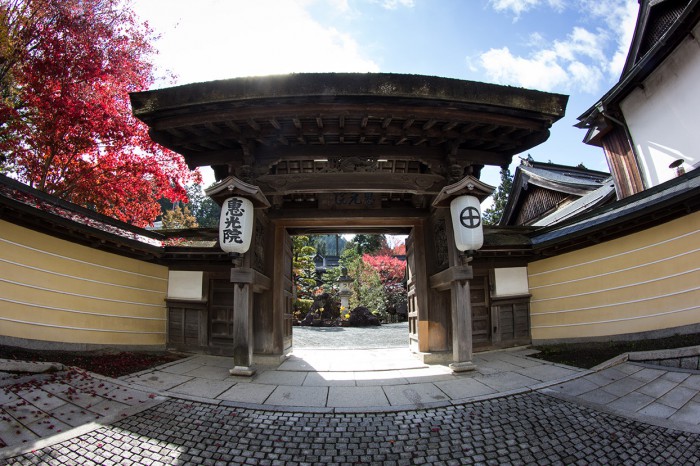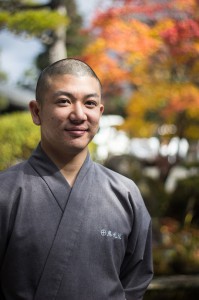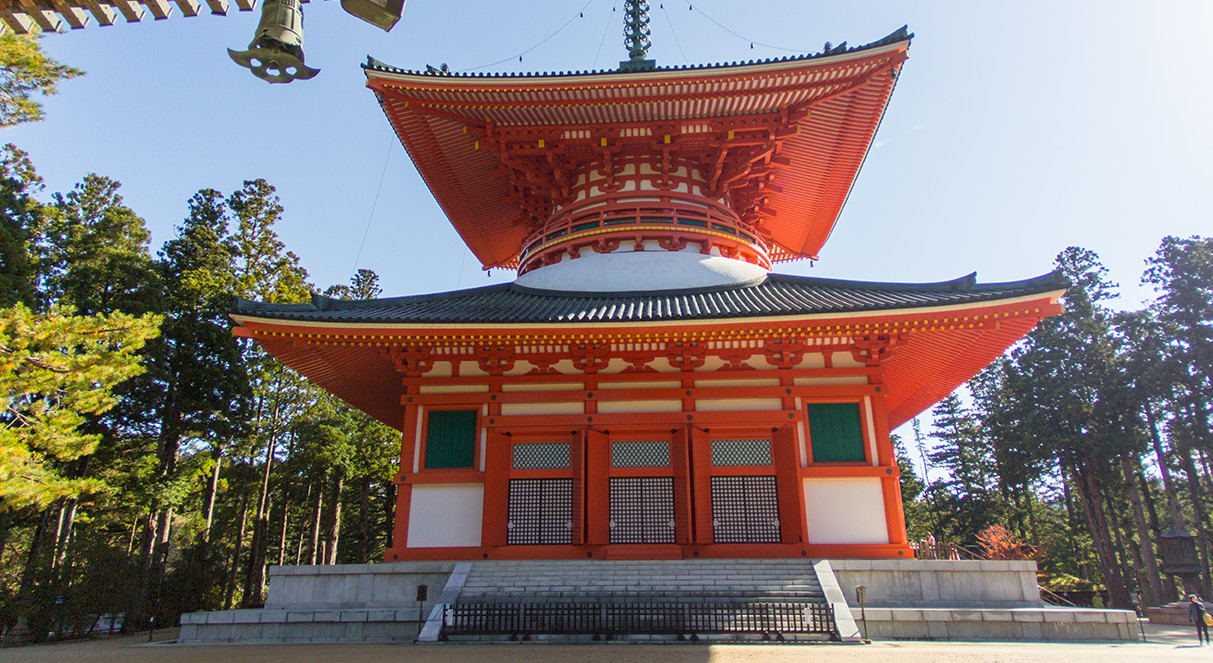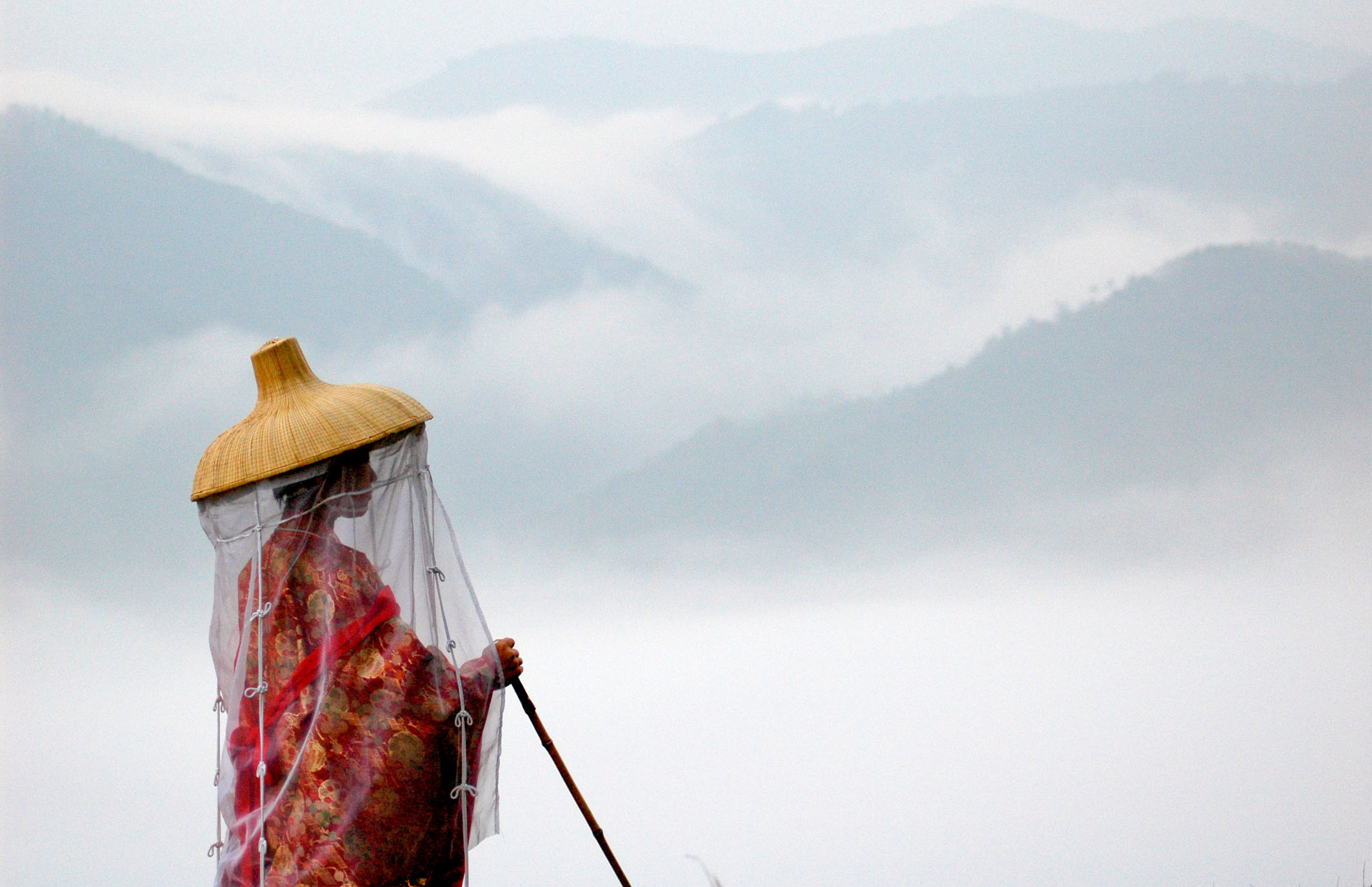Feature
Magnificent Mount Koya
Seeking enlightenment for the New Year? Consider a winter pilgrimage to Koyasan, the Japanese headquarters of Shingon Buddhism, which this year celebrates its 1,200th anniversary.
For the past 1,200 years, the quaint temple village of Koyasan has sat quietly up in Wakayama’s misty Kii Mountain Range; a training ground, sanctuary, and home for Shingon Buddhist monks, and a tranquil retreat for a handful of visitors looking for a place to quieten the mind and escape the urban rat race.
This secluded six-by-three-kilometer mountain prayer ground has lured pilgrims on their path to enlightenment since its establishment 1,200 years ago by Kukai (774–835), the eighth patriarch of Shingon Buddhism, posthumously known as Kobo Daishi (Grand Master). Even today, followers of the Shingon Buddhist sect will make the journey along the Koyasan choishi-michi, a 24-kilometer path from the base of the mountain to the mausoleum of founder Kobo Daishi in Okunoin graveyard. This spiritual mountain village was designated a UNESCO World Heritage site in 2004.
This recognition, however, has brought with it floods of curious visitors, and coupled this year with local and national promotion of the area as part of its 1,200-year celebration, Koyasan has become a true tourist hotspot. But don’t be dismayed – there is more than enough enlightenment to go around.
It is, however, a good idea to pick your time to visit wisely. While eager crowds now flood the tiny town in spring and autumn, eager to make the most of temperate weather while experiencing Mt. Koya in its seasonal colors, the cooler mountain-top temperatures in the summer also attract visitors seeking relief from heat and humidity. So if you’re prepared to bundle up, winter may just be your best bet for experiencing the original, still, quiet, meditative atmosphere of Koyasan.

Entrance to Eko-in Temple in Kota. Photo: Jason Haidar
“The snow is the best in December,” said Nobuhiro Tamura, a young monk at Eko-in temple. “Some photographers stay here for a week to wait for the December snow. In December it is light and powdery, but snow in January and February is wet, heavy, and muddy!
“But it is really cold, especially at night,” he warned. “You should definitely ask the temple you plan to stay at in advance about their heating situation,” advised the 31-year-old with a grin.
One flow-on effect of taking in more tourists over recent years is that many temple rooms have become equipped with a few more mod-cons, portable gas heaters included.
Another flow-on effect of the new wave of foreign tourism to Koyasan is that Nobu was granted an opportunity he wouldn’t otherwise have had – to find his calling as a monk at Eko-in temple.
“My case is unusual. Normally, the monks here, they are from temple families – Japanese monks get married. So it’s tradition for a son or daughter to take over the family temple, and if they want to do that, they have to come to Koyasan to study for some years first. But I’m quite unusual. I’m from a regular family.”
Nobu was born and raised in Kobe, and his father is a businessman. He became friends with the son of the head priest at Eko-in temple in high school, before spending a year and a half studying in the UK. The English he learned living in Europe proved to be an asset when his high-school friend’s priest father asked him to come and work a part-time job at Eko-in helping English-speaking guests.

Eko-in monk Nobu. Photo: Jason Haidar
Approximately half of Koyasan’s 120 temples open their doors to visitors to stay overnight, allowing them a glimpse into the life of a monk, a chance to eat shojin ryori (traditional vegan temple cuisine), and take part in early-morning prayer sessions. Eko-in is the only temple in Koyasan that also conducts a goma (fire ritual) at 7:00 every morning (7:30 in the winter time) “to burn away sins and impurities,” informs Nobu.
Another unique Eko-in experience – Nobu takes his guests on night tours of the mysterious and enigmatic Okunoin cemetery, Japan’s oldest and largest graveyard. Holding more than 200,000 graves dating as far back as the 11th century, the picturesque burial ground stretches 1.9 kilometers from the entrance at Ichi-no-hashi bridge to founder Kobo Daishi’s place of final repose – a place where some believe he is still hidden away deep in meditation despite the passing of 1,200 years.
Rising out from behind and between mounted tombs, moss-covered gravestones, and torii gates on either side of the cemetery’s neatly paved paths are ancient cedar trees, thick and tall, that allow only patchy light to pass through, making the place tricky to photograph when the sun is out, but much easier under a cloud-covered winter sky.
Beautiful stone lanterns line the walkway that winds through the peaceful resting places of emperors, princes and princesses, and feudal Japanese samurai lords, including the graves of Japan’s three unifiers: Oda Nobunaga, Toyotomi Hideyoshi, and Tokugawa Ieyasu. But you don’t have to be a famous historical figure to be buried at Okunoin, in fact you don’t even have to be Buddhist.
“If you like the philosophy of Kobo Daishi, you can have a tomb here. Doesn’t matter if you are Christian or Buddhist, we don’t care at all. If you are rich or poor, we don’t care,” explained Nobu humbly. Although you do need a bit of cash to secure your slot – a standard three meter by three meter plot with the gravestone will set you back ¥3 million, and you can rent the space for 50 years. After 50 years your family can take it over as long as they make another contract and pay the going rate.
On his Okunoin tours, Nobu mixes in cemetery folklore with basic teachings of Shingon Buddhism. As for the fun folklore, Nobu tells three stories. The first is that somewhere in Okunoin there is a rock that, if you put it to your ear, you can hear the sound of hell.
“I don’t recommend you to try it,” chuckles Nobu.
The eeriest is about the Okunoin well. “There’s a well in the cemetery where some people, they can not see their reflection in the water. There’s nothing. It means they are going to be dead within three years.” If you’re fortunate enough to find your reflection in the well, you still have to pass the stairs test on the other side of it. The superstition is similar – if you trip and fall on the stairs, you are dead within three years. So if you opt for the night tour, wear decent shoes, and don’t forget your flashlight.
[box]
Booking a Temple Stay
The official Koyasan reservation service (http://eng.shukubo.net) will not operate from Dec 26th Jan 5th so it is recommended to contact temples directly, or use another booking site such as Rakuten, JAPANiCAN, TripAdvisor, or booking.com
Email ekoin@mbox.co.jp to make a reservation at Eko-in temple.
Area Highlights
Okunoin – Japan’s oldest and largest cemetery situated at the very east end of the village (walking distance from the town center and all temples).
Konpon Daito (Main Great Stupa) – Coated in the blazing “shrine orange” color, this 48.5-meter tall structure stands out from the other wooden structures in the area. Said to be the first two-story pagoda in Japan, with the current reconstruction dating back to 1937.
Banryutei Garden – the largest rock garden in Japan (2,340 square meters). Made of 140 pieces of granite rocks, the design is of a pair of dragons emerging from a sea of clouds to guard the inner building.
Getting There from Osaka
Nankai Koya Line from Namba Stn to Gokurakubashi Stn. At Gokurakubashi, transfer to the cable car. From the top station, take a five-minute bus ride into the town centre. To save money, consider using a Koyasan World Heritage Ticket or a Kansai Thru Pass.
[/box]
荘厳なる高野山
新しい年を悟りの境地で過ごしたいあなたには、高野山への冬季巡礼をお薦めしよう。2016年、真言宗の総本山は開山1,200年を迎える。
和歌山県にある高野山の古色蒼然とした境内は、過去1,200年にわたって霧深い紀伊山地の上に鎮座してきた。修行の場であり、巡礼の聖地であり、真言宗の総本山であり、都会での慌ただしい暮らしから抜けだして心の平穏を求める人々のための瞑想の場もである。
東西6km、南北3kmの広大な敷地に開かれた山寺は、悟りを求める巡礼者たちの目的地であった。高野山を開いたのは真言八祖八代、死後に弘法大師の名を授けられた空海(774〜835年)である。今日でも真言宗の僧侶たちが町石道から全長24kmの表参道を登り、高野山奥の院にある弘法大師御廟を目指して巡礼をおこなう。
2004年、この聖なる山上の寺院はユネスコ世界遺産に指定された。開山1,200年を記念する地域や国ぐるみの宣伝活動も手伝って、いまや高野山は物見高い訪問客が押し寄せる正真正銘の一大観光地となっている。
この地には、いつ訪れても人々を触発する魅力がある。だから混雑にことさら失望する必要もないのだが、それでも高野山を訪れる時期は選んだほうが賢明だ。この小さな宗教都市に人々が殺到するのは気候と景色に恵まれた春と秋。夏もまた、暑さや湿気から逃れられる避暑地として人気がある。すなわち、寒さに耐える覚悟と準備さえあれば、元来の高野山が持つ落ち着いた瞑想的な雰囲気を体験できるベストシーズンは冬ということになる。31歳になる恵光院の若き僧侶、田村暢啓さんが冬の高野山の魅力を説明してくれる。
「高野山の雪は12月がいちばん。その雪を待って、12月に1週間も滞在する写真家の方がいらっしゃるほどです。12月は軽い粉雪ですが、1月や2月は湿ったドカ雪で泥んこになりますよ」
それでもやはり夜の冷え込みには注意をしたほうがいいと、田村さんは笑いながら警告する。
「特に夜の寒さはこたえます。宿泊予定の寺の暖房設備については、事前に確認しておいたほうがいいでしょう」
増加する観光客を迎え招き入れるため、多くの寺でポータブルガスヒーターなどの最新設備が導入されるようになったのは喜ばしいことだ。
そして近年のもうひとつの大きな変化といえば、外国人観光客が増えたことである。実はこの現象によって、田村暢啓さんにも思いがけない運命が開けることになった。彼が恵光院の僧侶という天職に出会ったいきさつは意外なものだった。
「私の来歴は変わっています。通常、高野山に来る僧侶はみなお寺の跡継ぎ。日本では住職の息子か娘が寺を継ぐのがならわしで、そのためにはまず高野山で何年か修行を積まなければなりません。でも私はごく普通の家庭で生まれたので、事情がまったく異なるのです」
ノブこと田村暢啓さんは神戸で生まれ、父親はビジネスマンという一般的な家庭で育った。1年半の英国留学を経験したが、そのヨーロッパ仕込みの英語力に目をつけたのが、高校時代からの友人の父親である恵光院の住職だった。外国人客の対応役として、パートタイムで働きに来てくれないかと頼まれたのだ。
「住職の言葉を通訳しなければならないので、翻訳しながら高野山や真言宗のことをたくさん学んだのです。そしてある日、『僧侶になる気はあるか』と住職が訊ねてきました。それで私は仏門に入ることを決心したというわけなんです」
そんな自らの来歴を話す田村さんは、どこか誇らしげだ。
高野山には約120軒の寺院があり、そのおよそ半数は宿泊を受け付けている。一般客にとっては、僧侶の生活ぶりに触れ、精進料理を味わい、朝のお勤めに参加するチャンスでもある。高野山で唯一、護摩法要をおこなっているのが恵光院だ。護摩は煩悩や不浄を焼き払うための儀式。朝7時(冬季は7時半)から毎日実施されているのだと田村さんが教えてくれた。
恵光院ならではのユニークな体験はもうひとつある。神秘的で謎めいた奥之院の墓地を、夜間に田村さんが案内してくれるナイトツアーだ。ここは日本最古かつ最大の墓地として知られており、11世紀の古墓を含む総勢20万基以上の墓がある。一の橋にある入り口から弘法大師が眠る御廟まで、壮観な埋葬地が1.9kmも続く。死後千年以上経った空海が、今でもこの墓地のどこかで深い瞑想を続けていると信じる者もいる。
積み上げられ、苔がむした墓石。墓地の両側にある鳥居。その背後の舗装された小道の両側には、堂々たる杉の巨木が並ぶ。そのため昼間でも光はまばらに差し込むばかりで、日が暮れてしまうと写真撮影が難しい。でも雲が垂れ込めた冬空の下なら、うまく撮影することができるのである。
美しい石灯籠が並ぶ歩道はくねくねと曲がり、歴代の天皇、皇太子、皇女、大名らが静かに眠る墓標を通り過ぎる。三大武将として名高い織田信長、豊臣秀吉、徳川家康の墓もここにある。だが奥之院に葬られる人が、歴史的な有名人に限られているわけではない。実際のところ、仏教徒である必要もないのだと田村さんが慎ましやかに説明する。
「弘法大師の思想に共感する方なら、ここにお墓を建てることができます。キリスト教徒でも、仏教徒でも、私たちはまったく区別しません」
もちろん墓地を確保するために幾ばくかのお金は必要だ。3m四方の標準的な区画が墓石付きで300万円。権利は50年で、50年後に家族が契約更新の料金を支払えばそのまま墓地を引き継ぐことができる。
田村さんの奥之院ナイトツアーは、墓地の民俗学と真言宗の基本的な思想について教えてくれる。とっておきの民間伝承は3つ。そのひとつは、奥之院にある岩の言い伝えだ。その岩に耳をつけると、地獄の音が聞こえてくるのだという。「おすすめはしませんけどね」と田村さんは笑う。そしていちばん不気味なのは、奥之院の井戸にまつわる言い伝えだ。
「この井戸を覗き込んで、もし水に映る自分の顔が見えなかったら、その人は3年以内に亡くなるという言い伝えがあるんです」
そして運良く井戸に映る自分の姿が見えても、まだ安心はできない。井戸の反対側にある階段を歩いて転んでしまったら、やはり3年以内に死ぬというのだ。だから忠告しておく。ナイトツアーに参加するなら、しっかりした靴で足元を固め、懐中電灯を忘れないようにしよう。















